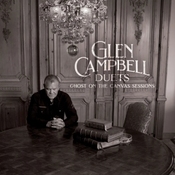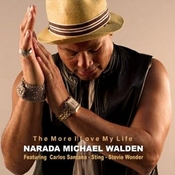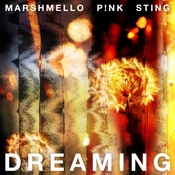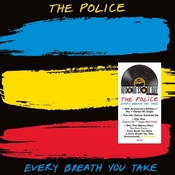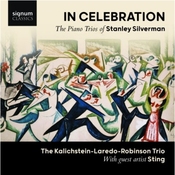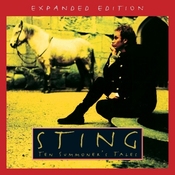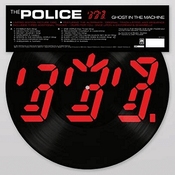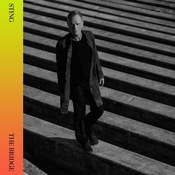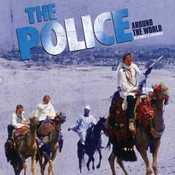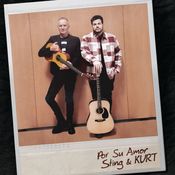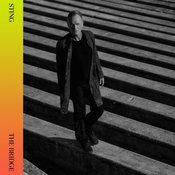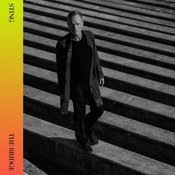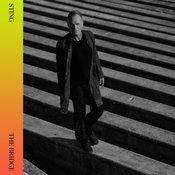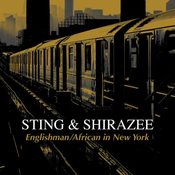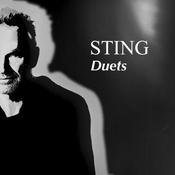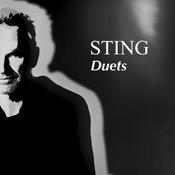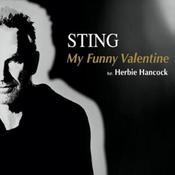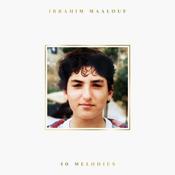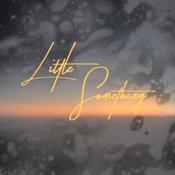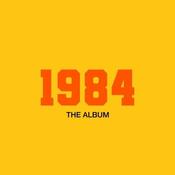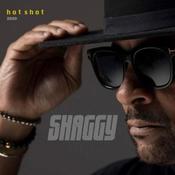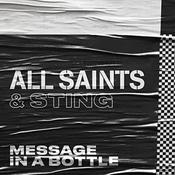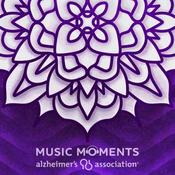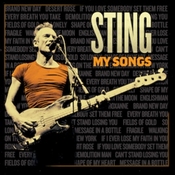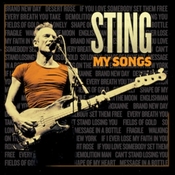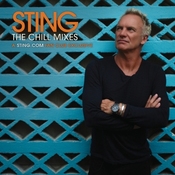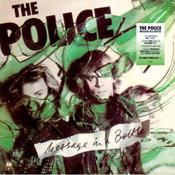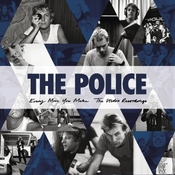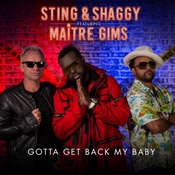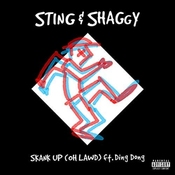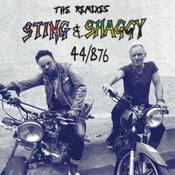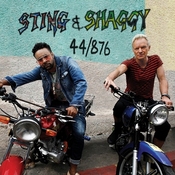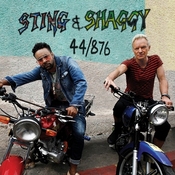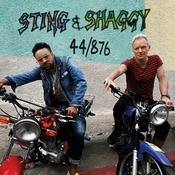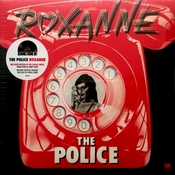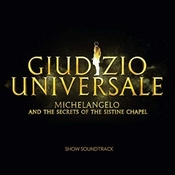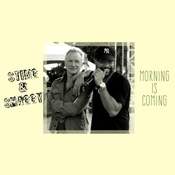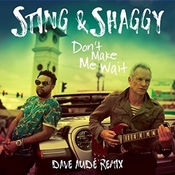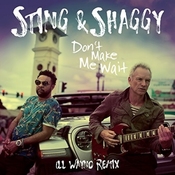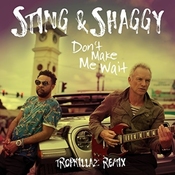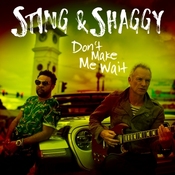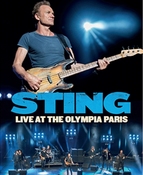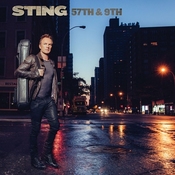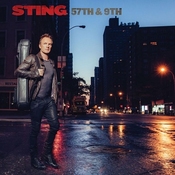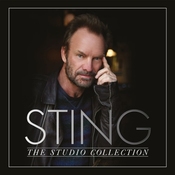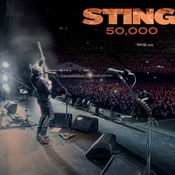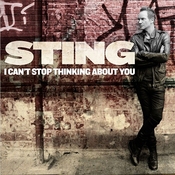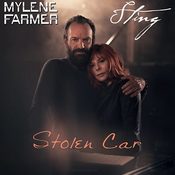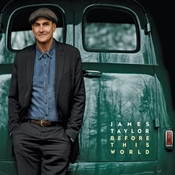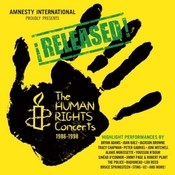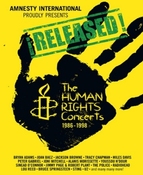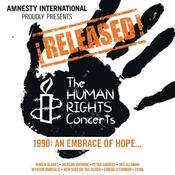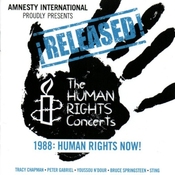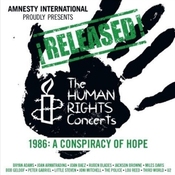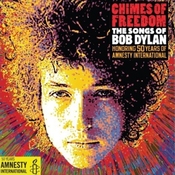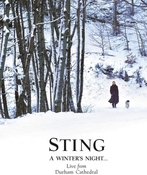Synchronicity 6-Disc Limited Edition Deluxe Boxset
- Synchronicity I lyrics
- Walking In Your Footsteps lyrics
- O My God lyrics
- Mother lyrics
- Miss Gradenko lyrics
- Synchronicity II lyrics
- Every Breath You Take lyrics
- King Of Pain lyrics
- Wrapped Around Your Finger lyrics
- Tea In The Sahara lyrics
- Murder By Numbers lyrics
- Truth Hits Everybody (Remix) lyrics
- Man In A Suitcase (Live At The Variety Arts Theatre, Los Angeles, USA 16.01.81) lyrics
- Someone To Talk To lyrics
- Message In A Bottle (Live At The Gusman Cultural Center, Miami, USA 26.10.79) lyrics
- I Burn For You lyrics
- Once Upon A Daydream lyrics
- Tea In The Sahara (Live At The Omni, Atlanta, USA 03.11.83) lyrics
- Every Breath You Take (Backing Track)
- Roxanne (Backing Track)
- Wrapped Around Your Finger (Live At The Omni, Atlanta, USA 03.11.83) lyrics
- Every Bomb You Make
- Walking On The Moon (Live At The Omni, Atlanta, USA 03.11.83) lyrics
- Hole In My Life (Live At The Omni, Atlanta, USA 03.11.83) lyrics
- One World (Not Three) (Live At The Omni, Atlanta, USA 03.11.83) lyrics
- Invisible Sun (Live At The Omni, Atlanta, USA 02.11.83) lyrics
- Murder By Numbers (Live At The Omni, Atlanta, USA 02.11.83) lyrics
- Walking In Your Footsteps (Derangement)
- Tea In The Sahara (Derangement)
- Synchronicity I (Demo)
- Synchronicity I (Alternate Mix)
- Synchronicity I (Instrumental)
- Walking In Your Footsteps (Alternate Version)
- Walking In Your Footsteps (Alternate Mix)
- O My God (Demo)
- O My God (Outtake)
- O My God (OBX Version)
- O My God (Alternate Mix)
- Mother (Alternate Version)
- Mother (Instrumental)
- Miss Gradenko (Alternate Mix)
- Synchronicity II (Demo)
- Synchronicity II (Outtake)
- Synchronicity II (Extended Version)
- Synchronicity II (Alternate Mix)
- Synchronicity II (Instrumental)
- Every Breath You Take (Demo)
- Every Breath You Take (Outtake)
- Every Breath You Take (Alternate Mix)
- King Of Pain (Demo)
- King Of Pain (Alternate Version)
- King Of Pain (Alternate Mix)
- Wrapped Around Your Finger (Demo)
- Wrapped Around Your Finger (Alternate Mix)
- Wrapped Around Your Finger (Instrumental)
- Tea In The Sahara (Demo)
- Tea In The Sahara (Alternate Mix)
- Murder By Numbers (Demo)
- I'm Blind (Demo)
- Loch
- Ragged Man
- Goodbye Tomorrow
- Truth Hits Everybody (Remix) (Outtake)
- Three Steps To Heaven
- Rock And Roll Music
- Synchronicity I (Live At The Oakland-Alameda County Coliseum, California, USA 10.09.83) lyrics
- Synchronicity II (Live At The Oakland-Alameda County Coliseum, California, USA 10.09.83) lyrics
- Walking In Your Footsteps (Live At The Oakland-Alameda County Coliseum, California, USA 10.09.83) lyrics
- Message In A Bottle (Live At The Oakland-Alameda County Coliseum, California, USA 10.09.83) lyrics
- Walking On The Moon (Live At The Oakland-Alameda County Coliseum, California, USA 10.09.83) lyrics
- O My God (Live At The Oakland-Alameda County Coliseum, California, USA 10.09.83) lyrics
- De Do Do Do, De Da Da Da (Live At The Oakland-Alameda County Coliseum, California, USA 10.09.83) lyrics
- Wrapped Around Your Finger (Live At The Oakland-Alameda County Coliseum, California, USA 10.09.83) lyrics
- Tea In The Sahara (Live At The Oakland-Alameda County Coliseum, California, USA 10.09.83) lyrics
- Spirits In the Material World (Live At The Oakland-Alameda County Coliseum, California, USA 10.09.83) lyrics
- Hole In My Life (Live At The Oakland-Alameda County Coliseum, California, USA 10.09.83) lyrics
- Invisible Sun (Live At The Oakland-Alameda County Coliseum, California, USA 10.09.83) lyrics
- One World (Not Three) (Live At The Oakland-Alameda County Coliseum, California, USA 10.09.83) lyrics
- King Of Pain (Live At The Oakland-Alameda County Coliseum, California, USA 10.09.83) lyrics
- Don't Stand So Close To Me (Live At The Oakland-Alameda County Coliseum, California, USA 10.09.83) lyrics
- Don't Stand So Close To Me (Live At The Oakland-Alameda County Coliseum, California, USA 10.09.83) lyrics
- Every Breath You Take (Live At The Oakland-Alameda County Coliseum, California, USA 10.09.83) lyrics
- Roxanne (Live At The Oakland-Alameda County Coliseum, California, USA 10.09.83) lyrics
- Can't Stand Losing You (Live At The Oakland-Alameda County Coliseum, California, USA 10.09.83) lyrics

Soundbites
26th July 2024 sees the global reissue of The Police ‘Synchronicity’, released in multiple formats, including a 6-disc Limited Edition Deluxe Boxset containing 55 previously unreleased tracks, new liner notes and interviews, rare archive memorabilia and unseen photographs. It’s a treasure trove for Police fans.
Synchronicity hit No.1 around the world, selling over 15 million globally (8.5 million sales of which were from the US alone). The No.1 hit single ‘Every Breath You Take’ would go on to be the most played song in radio history, with more than 15 million plays.
The critical reception for Synchronicity was no less impressive: the album received five Grammy Award nominations in 1984 and won three (Best Rock Performance by a Duo or Group with Vocal, Song of the Year (‘Every Breath You Take’) and Best Pop Performance by a Duo or Group with Vocal). The album also received press acclaim and has since appeared in many lists, including #159 in Rolling Stone Magazine’s Greatest 500 Albums of All Time.
This reissue has been three years in the making, created with the band’s involvement and endorsement. The accompanying 62-page boxset booklet contains extensive new liner notes written by acclaimed music journalist Jason Draper, who details the conception and infamous birth of arguably The Police’s masterpiece.
Over forty years on, all three members of the band continue to mark the legacy of The Police: Stewart Copeland published his Police Diaries and toured the world with his Police Deranged concerts. In October and November Stewart will perform across the UK with his new spoken-word show Have I said Too Much?; Andy Summers has published several photography books focusing on the Police era. He is currently touring his Cracked Lens + A Missing String show across the US; and Sting continues to tour extensively: his current US and European Tour runs throughout 2024 and features many Police songs among his solo work.
Like it's predecessor, 'Ghost In The Machine', the 'Synchronicity' album was recorded on Montserrat although writing for the album started as early as 1982 when Sting was staying in Jamaica. The band gathered on Montserrat in December 1982 along with producer Hugh Padgham they each brought their own songs.
It was important to Sting, that 'Synchronicity' sounded different. "There were a lot of clone groups who sounded like us coming up, so it was important that we didn't manufacture the kind of album where we all played our favourite licks. I felt the songs I wrote were different, so the playing had to be different," he said.
So the multi-layered sound of the previous album was stripped away and made more minimal. "I ultimately thought it sounded better that way. I can remove things without feeling threatened. I think it's my function to vanish behind the handiwork, in a sense, and just let it stand on its own," was how Sting saw it. "I think we'd become so refined as a group of musicians that we realised that the three instruments just playing solo and ensemble was perhaps the best way of doing it - and it just seemed to happen. The songs worked with three instruments. There were lots of overdubs, but the overall feel was spartan."
So what about the songs Well, as a starting point how about 'Every Breath You Take', now one of the most played records ever This track has two faces - one of surveillance and creepy observation the other of hopeless devotion - and to this day it amuses Sting that people choose this song for their wedding - "It's a very sinister song, but it's seductively dressed up." 'Wrapped Around Your Finger' was another spiteful song wrapped in a sugar coat, 'Synchronicity II' was as fine a piece of rock as the band ever recorded and 'Tea In The Sahara' was beautifully atmospheric. 'King of Pain's' vibrant imagery is set to a simple piano riff and 'O My God' had its genesis back in songs dating from Sting's days in Last Exit.
The album of course was huge. It simply went to the top of the charts on both sides of the Atlantic and just stayed there - 8 weeks in the UK and in the US where a huge stadium studio helped consolidate its position, for an incredible 17 weeks. But the success had its downside. Looking out from the stage of Shea Stadium at an audience of 70,000 people Sting realised that "It doesn't get any better than this we should really stop". Seven months later, the band played their final concert in Australia and went their separate ways. The Police had the courage to say goodbye at the very peak of their commercial and artistic abilities. In these days of big money reunion tours hardly a week goes by without a rumours surfacing that the Police are getting back together, but they've had the strength of character to resist and consequently their legend remains intact.
"This was our final studio album. I wrote a lot of these songs in Golden Eye, Ian Fleming's old home on the north shore of Jamaica. Britain had gone to war with Argentina over the Falklands. Young men were dying in the freezing waters of the South Atlantic, while I was gazing at sunspots on a clifftop overlooking the Caribbean. During this time I read Arthur Koestler, whose work in turn led me to Carl Jung. The title of the album refers to Jung's concept of meaningful coincidence. 'Synchronicity' was recorded on the island of Montserrat in 1983."
Sting, 'Lyrics', 10/07
"There was a book published called "Synchronicity" which is about the meaningfulness of apparent coincidences - is there any meaning in coincidence. And that's what I wanted this record to be about. It's a grand design, but I'm not sure if it come off or not. The concept interested me in that it was about accidents and some of the greatest things that happen in music with a band are accidental, or apparently accidental. Two members of the same band will hit the same chord, or the music will shift to an area that you both agree on for some inexplicable reason and you'll find yourself on the same wavelength. It's like within the parameters of the music there are lots of accidents and lots of things ricocheting off each other."
Sting, "In The Studio" Radio Show
"I think these lyrics are the best I've ever done. And, yes, it's been a year of hell and torture for me... And I know that without that torture and without that pain - without that awfulness - those lyrics wouldn't have been as good. So in a sense I'm very suspicious of myself. I wonder if I manufacture pain in order to create. Without being overly sentimental or indulgent. I have to say that, to me, the opportunity to express pain is the greatest... I don't really feel like telling anymore. I think I said it succinctly in the lyrics in a way that's meaningful and not overindulgent. To go over them now, well, it overstates it. I just want to say that if there's a feeling of sadness in any of the songs, it's genuine. That's all I want to say."
Sting, Musician, 6/83
"We only had one singer in the group and we respected the singer's right to choose what he says and sings. It's very important - it's not fair to make somebody sing words... we took ourselves seriously as being honest musicians which was very honourable but actually put limitations on Andy and I because we had to write songs that expressed Sting's emotions. And Sting and I have very, very different views of the world - very different politics, very different values. The things that I would express in a song are things that he would never even talk about. The conclusions I draw about life are very different to the conclusions that he draws, and so it was always a problem for me to write songs for him because I would have to try and get into his mind, and make his... speech, which is not a real thing. So it was best when I'd write instrumentals - that would work best. Fortunately, I didn't have that problem. I could play drums on a song whether I agreed with the lyric or not, it wasn't a big hassle for me. And I didn't disagree with the ideas that he expressed in his songs. We would disagree violently in prose. In fact a classic thing was where sitting around a coffee table arguing politics I'd hammer him into the ground and leave him speechless. He'd go away, the next day he'd come back with a song and he'd have a three word line such as "Russians love their children too" which would flatten me, blow me out of the water. Now if we argued about that, 'I have this reason what was fallacious about that' and 'this is misleading, how can you say this when'.. and all this stuff and he wouldn't have any answers. He's not actually very good at arguing in prose, but he can go away and in the privacy of his composition room, reduce the whole issue down to three words and blow any logical argument out of the water."
Stewart Copeland, "In The Studio" Radio Show
"The theory that the 'Synchronicity' album is entirely a function of Sting getting divorced is a gross oversimplification, and naive. Pain wasn't a new idea to me last year. But to have a creative outlet for feelings that would normally be ground up and internalised and reformed - you feel cauterised. Some of the things on that record are quite sinister and angry and twisted."
Sting, GQ, 6/85
"I felt very strongly that this album should say to the world that we are individuals. We are not joined at the hip; we are not a three-headed Hydra. We were very much thrown together by accident and we're very distinguished by strong egos. And we each have our own contributions to make. That was brought out on the album cover, where my idea was for each of us to have a separate strip and have the freedom to photographically do whatever we as individuals wanted, without knowing what the other two planned. I'll just find out when the album comes out. Hopefully, it'll be synchronistic."
Sting, Musician, 6/83
'Synchronicity' is really more autobiographical. It's about my mental breakdown and the putting back together of that personality. I'd hope that once I am mended my ideas would be more objective. I'm in a strange situation. When I was a schoolteacher, or on the dole, I wrote a lot of songs and I felt that I was writing for the man next to me in the dole queue. And now because I'm who I am I lead a rarefied kind of life that's unique to me and a few other people and the man in the street won't be interested in what I want to tell him. I write from experience, but it's not one that'll ring bells anywhere else. The 'on the road' songs have all been done, so¬Ö I write about my own psychological state hoping that someone will sympathise. It's weird, as a writer, which I primarily regard myself as."
Sting, NME, 12/83
"'Synchronicity' was a very personal statement for me, as opposed to a personal statement for the band. And the band was riding on the crest of a wave, but the music, the subjects were very personal to me... this was almost, and I'm trying to say this in a way that doesn't insult the other members of the band because I couldn't have done it without them - they're fantastic and I respect them - but this was almost a solo record in the sense that the subject matter was very personal to me. And I couldn't really share it. When I sat down with the band and discussed what we were going to tackle this was all I could write. 'Every Breath You Take', 'Wrapped Around Your Finger' were all about my life. And so that was the end of the Police because I realised that I couldn't involve this kind of personal work in a democratic process, at least not about the issues. So it was very clear to me during the making of this record this was the end of the Police. I didn't decide to do anything about it until after we'd played Shea Stadium. Shea Stadium was kind of the apex of what we'd set out to do. We played this huge historic stadium, we were the biggest band in the land, biggest record, biggest single - it doesn't get any better than this. All you can hope to do is keep repeating it. We all went back that night - we had a house in Long Island, all of us, with our families and we sat round, put the fire on, and we'd just had this huge triumph, and I turned to Andy and said 'It doesn't get any better than this we should really stop'. And surprisingly to me, Andy said 'Yeah, you're right, it can only go down from here.'
Sting, "In The Studio" Radio Show
"It coincides with my reading at the moment. You can substitute symbolist for synchronicity in the title song. The man's anxiety and aggression are symbolised by an event in a lake somewhere far away, without any causal connection between the two. That's synchronicity, drawing that analogy. In a sense, it's creating it because there are times in everyone's life when something you encounter becomes a symbol for your state of mind. Like in 'King Of Pain', where I conjured up symbols of pain and related them to my soul. A black spot on the sun struck me as being a very painful image, and I felt that was my soul up there on the sun. It's just projecting your state into the world of symbolism, which is what poetry's all about, really."
Sting, Musician, 6/83
"It was important that this album be different. There were a lot of clone groups who sounded like us coming up, so it was important that we didn't manufacture the kind of album where we all played our favourite licks. I felt the songs I wrote were different, so the playing had to be different. So if you don't recognise the Copeland sound. I think that's a good thing for all of us, because the reason he's such a good drummer is that he's fresh, he's original, he's spontaneous and he takes risks."
Sting, Musician, 6/83
"The title of the album refers to coincidence and things being connected without there being a logical link. For instance, in the title cut there's a domestic situation where there's a man who's on the edge of paranoia, and as his paranoia increases, a monster takes shape in a Scottish lake, the monster being a symbol for the man's anxiety. That's a synchronistic situation. They're not connected logically, but symbolically and emotionally they are. There's a song called 'King of Pain', which is a series of analogous statements about the soul: "There's a little black spot on the sun today / That's my soul up there... / There's a dead salmon in a waterfall... / There's a butterfly trapped in a spider's web." They're all images of entrapment and pain. The single, 'Every Breath You Take', is a very sad song and it makes me sad, but it's a wonderful sadness. It was written at a time of awful personal anguish, and it was a great catharsis for me to write that song."
Sting, Rolling Stone, 9/83
"My marriage had broken up by and I sat at the desk where Ian Fleming had written the James Bond books and wrote 'Every Breath You Take' and 'King Of Pain' and 'Wrapped Around Your Finger'. That really helped me. It was a healing process."
Sting, Q, 11/93
"I think we'd become so refined as a group of musicians that we realised that the three instruments just playing solo and ensemble was perhaps the best way of doing it - and it just seemed to happen. The songs worked with three instruments. There were lots of overdubs, but the overall feel was spartan."
Sting, Rolling Stone, 3/84
"'Synchronicity' went through all kinds of horrendous cogs and gears to come out, emotionally and technically, the way it did. My feeling before we made the album was that we had to change our sound, because there were a lot of clone groups who sounded a bit like us. That's flattering in a way, but I thought we should try to sound a little different, so we pared away the things people have come to expect in our music. Reggae, for instance, is more buried in the undercurrent of the music than it might have been in the past. I think this is a more refined record than we've previously made."
Sting, Rolling Stone, 9/83
"We were allowed to grow as a group and grow in stature in a very natural way, so by the time we released this album, we were ready to sell 5 million albums. I would imagine the next LP would be exponentially bigger than that. It's a case of statistical certainty. But I also think this is our best album, which I hope is the main reason."
Sting, Rolling Stone, 3/84
"I think there is a golden moment in a career when, very naturally, you put your finger out in front of you and you automatically touch the pulse of a lot of people. Like a kind of collective pulse. And you feel that, you feel your connection with it and therefore what you do, very naturally, is connect with it through your music and so you keep writing while you have your finger on this pulse. It's a very happy feeling - it's like the height of your popularity, you know that you do is going to connect in a very big way with a large group of people, and while that period lasts - and it can't last for ever - everything you touch turns this way. I don't feel so much connected to that now. I feel connected on a deeper level than the pulse. I feel connected to maybe less people but at a deeper level. But at the time, at the height of the Police's popularity we were connected to a mass consciousness if you like, a feeling - you can't intellectualise it - it's just a feeling and it reflects in record sales and stuff. So yeah, there is a moment when you think 'Oh, so that's what making it is'. You feel connected, you don't feel like your outside anymore, you are in fact the centre of something. You feel very much part of the web of communication."
Sting, "In The Studio" Radio Show
"The whole album was recorded in an unbelievably bad atmosphere. We hated each others guts, and we had no respect for each other. Actually, I did, but I just felt like a piece of shit."
Stewart Copeland, Revolver, 4/00
Backgrounder
Review from Rolling Stone by Kory Grow
The Police’s ‘Synchronicity’ Box Set Gets Inside the Dysfunction That Fuelled an Eighties Classic - The six-disc compendium contains outtakes, alternate lyrics, and a very strange-sounding "Every Breath You Take"
In 1983, sometime between the M*A*S*H finale, the shock of seeing Darth Vader’s face, and the Cabbage Patch Riots, the Police issued the year’s music blockbuster. The trio’s fifth and final album, Synchronicity, was almost immediately the best-selling LP released that year.
The record, now octuple platinum, was a cultural force: The New York Times likened it to Sgt. Pepper’s Lonely Hearts Club Band for pairing highbrow conceptualism (can you explain psychiatrist Carl Jung’s 1960 theory of “synchronicity”?) with tunes you could hum (who cares!). Meanwhile, Rolling Stone dubbed the album “a work of dazzling surfaces and glacial shadows.” It won the band three Grammys, and its centerpiece, “Every Breath You Take” was the year’s top single, while “Wrapped Around Your Finger” and “King of Pain” made the Top 10. The Police’s MTV-sponsored Synchronicity tour was one of the year’s biggest, and then a few years later the Police executed their biggest trick by breaking up at their commercial peak with no bad (let alone criminal) records to their name.
Now, a new super-deluxe, six-disc box set, Synchronicity (40th Anniversary Edition), reveals all of the magicians’ tricks with hours of demos, alternate versions of the songs with different lyrics, outtakes, and live recordings. Some of the archival material sounds better than what made the album, some of it is cringe-inducing, and all of it shows the process of what goes into making a record worthy of comparison to Sgt. Pepper.
It begins with the original album, remastered, but the sort of people who would spend over a hundred bucks on a six-disc Synchronicity box set are likely already familiar with every song, as well as the B sides and hard-to-find curiosities on the second disc. Nevertheless, they will likely appreciate nice-sounding versions of oddities like “Every Bomb You Make” and the karaoke-ready backing track to “Roxanne” (which Eddie Murphy desperately needed in 1982). The real appeal of the collection is its two discs’ worth of unreleased versions of every track, as well as a few castaways.
The most revealing moments lie in comparing Sting‘s demos to the full band’s renditions of songs, since you can hear how guitarist Andy Summers and drummer Stewart Copeland made the songs sound like the Police. The demo for “Synchronicity I” (or, as it was originally known, “A Causal Connecting Principal [sic]”) sounds kind of bland with only Sting’s Oberheim synth providing the music. The key is lower, and Mr. Sumner has to sing the lyrics really fast, since he ended up overlapping them later. Similarly, the “OBX” synth version of “O My God” sounds funky (in a bad way) with simplistic drums, but the outtake of “O My God” sounds funky in a good way literally with Sting playing Bootsy Collins–style rubber-band bass. The demo of the same song is a big jazz jam like Sting’s later solo music. The demo synths on “Wrapped Around Your Finger” sound even better than the album version.
The demo for “Every Breath You Take” is the apotheosis of Eighties synth-rock, recalling Kenny Loggins, mid-decade Rod Stewart, and the keyboard room at every Guitar Center auditioning rhythms at the same time. The lyrics and vocal melody are there, but the gauzy synths sound sleepy as they enfold Sting’s leering words. When you compare it with the outtake of the same song, a recording-studio rehearsal, you can hear how Summers’ jazzily ambiguous add9 and sus2 chords turn it into the Police; Summers even plays the finished song’s descending piano notes (which do sound better as piano notes on the album version). Meanwhile, the demo for “Murder by Numbers” is an upbeat ska track and not the snaky reggae jam it would become when Summers stepped up with some new music.
The alternate version of “Walking in Your Footsteps,” Sting’s meditation on dinosaurs and human peril, contains different lyrics: He sings “20 million years ago [dinosaurs] walked upon the planet” instead of the somewhat more accurate “50 million years ago” of the studio version. He also wisely cut verses like, “They live in a museum, it’s the only place you’ll see ’em” and, “Are we an endangered species when we walk in our own … faeces?” And the extended version of “Synchronicity II” contains a bridge, titled “Loch,” on which Summers plays Brian Eno–style atmospherics on a synth guitar. For better or worse, Sting’s “that’s my soul up there” responses on the “King of Pain” chorus are more coherent on the alternate versions than on the album version.
Lacklustre studio outtakes like Copeland’s “I’m Blind” and “Ragged Man,” which both surfaced on his Rumble Fish soundtrack, and Summers’ “Goodbye Tomorrow,” which later became the excellent Police B Side “Someone to Talk To,” justify why the band abandoned them at the time. Similarly, two ultra-reggae-fied covers of oldies - Eddie Cochrane’s “Three Steps to Heaven” and Chuck Berry’s “Rock and Roll Music” - show why it was right for them to reconsider making a covers album as their next record (which they apparently actually considered doing).
The live discs, recorded at Oakland’s Day on the Green before an audience of nearly 60,000 in the fall of 1983, show the band at its biggest. Synchronicity had already displaced Thriller as the bestselling album a couple of times, and the audience sounds thrilled to sing along with every word of “Every Breath You Take.” The backup singers, Michelle Cobb, Dolette McDonald, Tessa Niles, whose names are curiously missing in the box set’s booklet, help make the songs bigger. They echo Sting’s “They say the meek shall inherit the earth” on “Walking in Your Footsteps” (which has some insane jittery drumming by Copeland) and take over his brilliant “I can’t stand losing” refrain in “Can’t Stand Losing You” since Sting really couldn’t stand losing.
Plus, it’s a thrill to hear tens of thousands of people sing along with the globalism anthem “One World (Not Three),” joining in as Sting entreats, “It may seem a million miles away/But it gets a little closer every day” even if they probably went home without the song’s message sinking in. Nevertheless, the message is there.
The band members famously couldn’t play in the same sandbox together (maybe the song should have been “One Band (Not Three)”) and had to record Synchronicity in their own rooms, so the excellence of the original album seems like even more of an accomplishment when contextualized with all of the source material in the box set. Much like Talking Heads, the trio deftly funnelled their loves of Caribbean and African music into pop-rock with literary lyrics. Also like the Heads, they never put on airs of being anything other than British and American musicians. The Police wanted to write Billboard hits and sell out, something they attempted by appearing in a Wrigley’s gum ad before even releasing an album in 1978, and that spirit drove hit singles like “Message in a Bottle,” “Don’t Stand So Close to Me,” and “Every Little Thing She Does Is Magic.” They even titled an album Reggatta de Blanc (or “white reggae”); they knew the score, and this tour was their ultimate victory.
Listening to the original Synchronicity now, Sting’s ambition on the two title tracks still astounds. The way he’s able to reference W.B. Yeats’ “spiritus mundi” and Jung’s concept of meaningful coincidences in Part 1 and lead Broadway-style drama, contrasting a sense of English resignation with the birth of the Loch Ness monster in the second - and get a hit out of “Synchronicity II” - is inexplicable. (There still hasn’t been a better song in the past 40 years to include a lyric quite like “a humiliating kick in the crotch.”) And “O My God” still takes the biscuit with Sting playing the riff to “Day Tripper” on his bass while howling against God. Even the uncanniness of Summers’ “Mother” (a Middle Eastern–influenced Norman Bates blues song in 7/4, which Summers himself sings, making it the Ringo tune of the bunch) and Copeland’s short-and-sweet “Miss Gradenko” (which Sting wisely sings) help build a bridge to the record’s flawless second side.
“Every Breath You Take” still sounds seductive and quixotic (is it about an obsessive stalker or feuding Cold War nations?) and that’s why it has endured as the best of the songs on the album (though the less said of these days Puff Daddy’s “I’ll Be Missing You” the better). Sting wrote the song, as well as the two that follow it - “King of Pain” and “Wrapped Around Your Finger” - at James Bond novelist Ian Fleming’s desk in Oracabessa, Jamaica just after he left his wife for her best friend. Even if they both feel melodramatic (“Wrapped Around Your Finger” is both about relationship dynamics and a metaphor for a wedding ring), the music is still powerful. “Tea in the Sahara,” which takes its title and plot from a minor story in Paul Bowles’ novel, The Sheltering Sky, ends the album warmly with Summers’ atmospheric guitar and Sting’s bass taking the lead. (The bonus track, “Murder by Numbers” is just good fun.)
It feels like a time capsule and somehow head boy Sting never comes off preachy with all his dissertations the way he would within a year or two when he revisited the same subjects as a solo artist backed by jazz musicians on the breakup song “If You Love Somebody Set Them Free” (an update on “Wrapped Around Your Finger”) and the Cold War commentary “Russians” (a more direct “Every Breath”?). Like with the demos in the box set, it’s hard to picture Sting’s solo music a la carte becoming Police songs, which speaks volumes to how the trio’s dysfunction at the time worked in its favour.
Summers and Copeland rose to Sting’s ambitions and made them something bigger and more palatable, and all three members deserve credit for recognizing they wouldn’t be able to repeat the feat of Synchronicity (even if they did briefly reunite in 2007). Taken as a whole, the box set shows how perfect synchronicity happens only in fleeting moments - even if there’s a lot of woodshedding necessary to make it happen at all.
Review from Salon by Kenneth Womack
Police's "Synchronicity" 40th anniversary deluxe box set pops with energy - If you were in earshot of a radio at the time, “Every Breath You Take” was embedded in your daily soundtrack...
Online prognosticator Rick Beato recently opined that in 2100, acts like the Beatles, Nirvana, Queen, and, yes, the Police will still be in heavy rotation when it comes to celebrating the rock era. Beato makes a solid, data-supported case. But as a college professor who teaches popular music, I have observed that today’s students seem just as besotted, if not more so, with Pink Floyd and Led Zeppelin.
So will the Police, those purveyors of white reggae with just five studio albums to their name, really ply their way into the next century? The new deluxe box set for "Synchronicity," the band’s megaselling 1983 LP, certainly makes a strong case of its own. Back in the day, the Grammy-winning album was propelled by a quartet of hit singles in “Every Breath You Take,” “King of Pain,” “Wrapped Around Your Finger” and “Synchronicity II.” If you were in earshot of a radio at the time, “Every Breath You Take” was embedded in your daily soundtrack.
As it happened, it was a minor miracle that the Police reunited at all to create "Synchronicity." The band had long been plagued by interpersonal rancor — lead singer Sting and drummer Stewart Copeland were the principal combatants. But the results speak for themselves, with the group abandoning its reggae roots for an album that brims with the atmospherics, jazz hues and world music that would characterize Sting’s solo career.
I am delighted to report that the deluxe edition of "Synchronicity" will be a joy for older fans and newly minted Police aficionados alike. I have long been dissatisfied with the original digital versions of the LP, which often sounded muted. The new version, remastered from the original tapes, outpaces earlier editions in every respect. The album absolutely pops with energy.
And folks who enjoy generous helpings of ancillary material will not be disappointed. The super deluxe version not only includes the remastered album, but numerous outtakes and demo recordings that amount to some 84 tracks. Listening to the various takes of “Synchronicity II” as it snakes its way through the production process is worth the price of admission in and of itself. You can literally follow along as new layers of terror and intrigue accrue as Sting relates his mysterious tale about the primordial slime that gathers in the heart of “a dark Scottish lake.”
Will music lovers still be seeking out the Police in droves in 2100? I honestly haven’t got a clue. Predicting the multitudinous sociocultural shifts that are bound to occur between now and then is a fool’s errand. But I know this: as long as humans have ears and access to the world’s digitized back catalog, the Police will find devoted adherents.
Review from Mojo by Tom Doyle
The Police Synchronicity Review: “A weird mainstream record by an altogether underrated group.”
Vastly expanded reissue charts the making of the group’s highly fractious and hugely successful final album.
December 1982 and out there in the wider world, The Police were fast becoming the biggest band on the planet: a string of international hits, two US Top 5 and three UK Number 1 albums, a couple of Grammys, a Brit, fan adulation, the lot. Inside AIR Studios on the Caribbean island of Montserrat, however, as they set about making their fifth album, bitterness and resentment hung heavy in the air between the three members of the group.
The main source of disagreement was, of course, creative control. When singer/bassist Gordon ‘Sting’ Sumner and drummer Stewart Copeland had joined forces in early 1977 and drafted in guitarist Andy Summers later that year (replacing original guitarist Henry Padovani), the group’s frontman was a novice relative to his bandmates: Copeland had spent a couple of years in English proggers Curved Air; Summers was a veteran of tours and sessions with everyone from Soft Machine to Neil Sedaka. As the chief songwriter and sole hitmaker, though, Sting’s inherent confidence had grown and grown, and he now insisted on absolutely calling the shots in the studio.
AIR may have been in an idyllic setting, but as Copeland tells MOJO today, “we soon turned it into a living hell”. The Police had used the studio two years previously for the recording of their fourth LP, Ghost In The Machine, co-producing with Hugh Padgham (Peter Gabriel, Phil Collins) and this time around employed the same set-up: Sting in the control room, Summers in the live room, and Copeland with his kit in the wooden-walled dining room of an adjacent building. The goal was sonic isolation, but at the start of the sessions for Synchronicity, the arrangement only served to physically reinforce the intra-band divisions.
The first serious crack appeared when the trio were working up one of Sting’s new songs, Every Breath You Take, from the singer’s solo demo. He and the drummer argued over the rhythmic direction and an almighty ruckus ensued. Suddenly, it looked as if a fifth Police LP was unachievable and that the sessions were off.
A peace-making summit was hastily negotiated. The band’s manager, Miles Copeland (the drummer’s eldest brother), pointed out that AIR’s owner, George Martin, was on the island and suggested they should ask him to oversee the sessions. Summers was duly dispatched to Martin’s house through what he now remembers as “the dense and intense jungles of Montserrat”. The sage, laid-back producer politely declined to get involved but said, “I’m sure you can work it out.” The guitarist returned to the studio, related this simple, contemplative advice; the others agreed, and the tape rolled again.
The beat for Every Breath You Take was pieced together element by element, losing Copeland’s virtuosic drumming but resulting in a metronomic, almost Kraftwerk-like precision. It’s one of the tracks whose development, from demo through studio rehearsal, is charted in this six-disc reissue of the group’s most successful, and final LP.
If The Police were never cool (see Sting’s lyrical pretentions, Jamaican vocal inflections and unabashed self-love), in terms of their constituent parts they were dazzlingly inventive musicians who conspired to make a series of singles – and The Police were always essentially a singles band – which were enormous, era-defining hits, but that in retrospect are striking in their artfulness. The sparse, haunting dub of Walking On The Moon, for one, now sounds like a deeply strange record to reach UK Number 1.
Here, the 36 unreleased tracks (albeit including alternate or instrumental versions of the LP cuts) highlight the outside influences that each brought to the table. Summers had just made an album, 1982’s I Advance Masked, with Robert Fripp, and his lead vocal on Mother – boldly tracklisted midway through side one – involves a manic, screaming performance that sounds as if he’s auditioning to be Adrian Belew’s replacement in (the similarly troubled) King Crimson. Copeland contributed the tumbling Afrobeat of Miss Gradenko to the finished record, while his unused contributions included I’m Blind (odd new wave) and the instrumental, organ-led Ragged Man, both recycled for his soundtrack to Francis Ford Coppola’s 1983 film Rumble Fish.
Elsewhere, Sting’s demos reveal someone attempting to break free of the confines of the three-piece band, whether with the aid of the synth arpeggios of Synchronicity I or the JBs-styled brass stabs of O My God. The album’s title was, meanwhile, inspired by Arthur Koestler’s 1972 book The Roots Of Coincidence, which partly explored the Jungian theory of synchronicity (involving a psychological state somehow causing a physical event). In the third single released from the album, the propulsive Synchronicity II, the singer painted a picture of a browbeaten man whose growing anxiety coincides with the faraway surfacing of the Loch Ness Monster. If it stretched Jung’s theory to snapping point, it was a towering rocker nonetheless.
While some of the tracks suffered from the thin, digital reverb-y aural trends of the era, Padgham was a good choice for co-producer, having engineered Peter Gabriel’s ground-breaking third LP, whose echoes could be heard in the marimba-led atmosphere of King Of Pain or the sequenced polyrhythms of Walking In Your Footsteps. The overall result was an art rock record that managed to yield four hits, including the brooding ballad Wrapped Around Your Finger, with its none-more-Sting, Greek mythology-referencing opening couplet, “You consider me the young apprentice/Caught between the Scylla and Charybdis.”
Following the album’s June 1983 release, in spite of the bad blood between them, The Police managed to complete a nine-month-long 1983-4 world tour, represented here by selected tracks from the Omni in Atlanta and a full show from the Oakland-Alameda County Coliseum that showcase the band’s live vitality and slickness. Onstage at Shea Stadium in New York, Sting quipped “we’d like to thank The Beatles for lending us their stadium”, but mentally took the decision there and then to quit the band, likely hastened by a pre-gig fight with Copeland that left the latter with a fractured rib.
By the end of the Synchronicity campaign, The Police were indeed the most successful band in the world, with 10 million sales of the album and another three Grammys in the bag. Which is all the more remarkable really since, listening back to it now, it remains a pretty weird mainstream record, by an altogether underrated group.
Review from Classic Rock by Rich Davenport
The Police's best-selling Synchronicity improves with added archive gold...
In his autobiography One Train Later, former Police guitarist Andy Summers recalls that by 1981’s Ghost In The Machine the band’s success was such that those around them were “[telling] us what we want[ed] to hear”, and by Synchronicity (1983) had escalated to the point that they “could record Mary Had A Little Lamb, and it… would go to Number One”.
While there’s no arguing with Synchronicity’s classic status, Summers’s observations regarding objectivity appear especially pertinent in the light of this new six-CD expanded edition, which adds unreleased, arguably superior, versions of weaker tracks that made the final cut.
New remastering bolsters the album’s strengths, adding warmth and definition to King Of Pain, Wrapped Around Your Finger and Every Breath You Take, career-high examples of Sting’s craft as a songwriter, of Summers’s ability to strengthen the material with melodic counterpoints, and of the centrality of Stewart Copeland’s inventive rhythmic drive to the Police’s appeal.
With an album’s worth of period B-sides and bonus tracks, the set’s two discs of unreleased material strike gold with Sting’s brisk, electro-pop demo of Murder By Numbers, and a slinkier, horn-driven funk arrangement of O My God from the Synchronicity sessions, both infinitely more enjoyable than the bland album versions.
Finally, a scorching 19-song live set finds Summers and Copeland’s post-studio arrangement modifications transforming Walking In Your Footsteps from clunker to contender, and supports Sting’s claim (in the expansive accompanying book) that the band “finished at the top”.
Review from Spill magazine
The Police owned 1983. Synchronicity was the album of that year, featuring five hit singles, selling over eight million copies in the world and was nominated for five Grammys. One would hear it everywhere, radio, stores, and even television. It was also an international chart topper and their tour of the album was an instant sell out. Following the tour, The Police called it quits. Like The Beatles, they went out on top. And like The Beatles, whom they credit for influencing their decision to put together and release the deluxe version of the album, Synchronicity has returned in all its glory.
Synchronicity was the fifth album by The Police, and one could see how they reached this pinnacle. Each album by them, from their debut, Outlandos d’Amour in 1978 to 1981’s Ghost In The Machine paved the road for Synchronicity. It is hard now to imagine the impact of the album. In 1983, the album was very unique and had its own style. It really stood out from the other music of that year. The Police mixed jazz, pop, a bit of reggae, and rock to release a very original and influential album. From the dance rock of “Synchronicity I” to the jazzy “O My God” to the ballads (such as “Wrapped Around Your Finger”), the album was really a cornucopia of well-produced sounds. Credit must be given to the co-producer of the album, Hugh Padgham, who had a key role in the overall sound of the album.
The Police were always known for their musicianship, but on Synchronicity they all excelled. And yet, not one member was trying to steal the show. They worked as a unit and seemed to bring the best out of each other. On this new box set, the deluxe version, listening to the demos and alternative versions, gives a small glimpse into not only their creative process, but how they related to one another. “Murder By Numbers”, a song that was originally only on the cassette version of the album, is here in all of its glory. But the demo shows how far they went with the song. The box set also allows fans to hear The Police having some fun with their jams of “Rock And Roll Music” and the Eddie Cochrane classic “Three Steps To Heaven”.
There is also a lot of live material in the set, including a never before heard concert of The Police at The Oakland-Alameda County Coliseum in Sept. 1983. The Police never failed to impress their fans during concerts. They proved that they were not a studio band when they stepped on the stage. One can hear the energy and excitement the band brings to the stage, and yes the fun. The Police sound like they are having as much fun as the audience in this concert.
The box set also has some surprises and treats never heard before, such as “Every Bomb You Make” a parody of “Every Breath You Take” for the television show, Spitting Image. It is amazing to hear Sting sing the different lyrics that are sadly relevant today. There is an early version of “Loch”, a section of “Synchronicity II” on its own which is quite interesting. And there are some previously unreleased gems, such as the instrumental “Ragged Man” and “Goodbye Tomorrow”, which became “Someone To Talk To”.
After the Synchronicity tour the band split and all had successful solo careers, again, much like The Beatles. And although there have been occasional reunions, The Police had a definite beginning, middle and end. Synchronicity was a perfect way for the band to bow out. They produced a masterpiece full of brilliant songs. This Super Deluxe Edition of Synchronicity is long overdue. It is a box set jammed full of essential music and is a document of a band hitting their creative and commercial peak and calling it a day. It is beautifully packaged with a book about the album and The Police at the time. This is a great listening experience.
Review from Sound and Vision by Mike Mettler
he first time I became aware of the word synchronicity was when I saw it being used as the title of The Police’s fifth and final studio album released on A&M in June 1983. My then-bookwormish self was not yet up to speed on Carl Jung’s hypotheses about meaningful yet seemingly random intersectivity, nor the parapsychology principles laid out in Arthur Koestler’s 1972 book The Roots of Coincidence - but The Police’s ever-erudite bassist, vocalist, chief songwriter, and former schoolteacher Sting hipped me to Jung and Koestler’s philosophies right quick. It was quite akin to exploring the origins of his Vladimir Nabokov reference in “Don’t Stand So Close to Me,” the lead track on October 1980’s Zenyatta Mondatta (A&M), and how philosopher George Gurdjieff inspired the lyrical content of my favorite Police song, “Secret Journey,” on October 1981’s Ghost in the Machine (also on A&M).
As commercially successful and artistically creative as its predecessor Ghost was, Synchronicity is the album that vaulted the blended British/American trio into the megaplatinum global-phenomenon stratosphere, itself a 10-track master class of envelope-pushing pop songwriting, clever and sometimes challenging song arrangements, and truly elite musicianship. To properly fete The Police’s studio swan song, A&M/Polydor/Universal Music Recordings recently issued several expanded multiformat editions.
The linchpin is the 84-track 6CD Synchronicity box set (SRP: $124.99; available on Music Direct as well as other online outlets, if MD happens to be out of stock) with the original 10-song album plus the top-tier bonus track “Murder by Numbers” on CD1, all remastered directly from the original source tapes. CD2 boasts 18 tracks containing all 7 original 7-inch and 12-inch B-sides plus 11 exclusive non-album tracks making their on-CD debuts. CD3 and CD4 house 36 tracks comprised of previously unreleased alternate takes of each Synchronicity song alongside early demos, other outtakes, and covers. Finally, CD5 and CD6 host 19 previously unreleased live recordings from the band’s September 10, 1983, show at the Oakland-Alameda Coliseum in California.
The 4LP vinyl edition trims those tracks practically in half from 84 to 43 mainly by scotching the bulk of the live material for an albeit higher SRP of $174.99 (also available on Music Direct, and elsewhere) - but it’s a wholly worthwhile obtainment for the analog-inclined amongst us.
Additionally, a limited-edition 1LP picture disc subtitled Alternate Sequence reinstates the album’s original running order - one I very much prefer, truth be told, just as I do with the reordered and expanded Ghost in the Machine picture disc sequencing. (If you want to experience that more instinctual flow of the core Synchronicity album as initially intended, the SRP is $35.99, and it too can be found on, you guessed it, Music Direct.)
Interestingly, both the 6CD and 4LP box sets are full-album size. These days, CD boxes tend to come in clamshell form, but I have no problem with this decision. The CD box’s dimensions are 12⅞ x 12⅞ x 1 inches (w/h/d), essentially mirrored by that of the slightly chunkier 4LP set whose physical difference is its 1⅛-inch depth. The 4LPs are all toploaders, yet it’s not easily discernible which one is which since the type on each LP back cover is so bleepin’ minuscule - plus, the backside of each box fails to include any tracklisting details whatsoever. Even so, both boxes will look fairly, well, synchronous next to each other on any LP-size shelving unit.
The CDs reside in half-pockets within the included 60-page hardbound book - the first troika on the left inside cover, the second grouping triangled out back on the inner right - and all are easily removable. The book also contains a deeply informative essay with no-holds-barred observations from Sting, guitarist Andy Summers, and drummer Stewart Copeland, plus page after page filled with copious shots of memorabilia, myriad cover artwork options, tape boxes, tour shirts, backstage passes, and more (much more).
The genius of Synchronicity may be blunted by its inherent four-decade familiarity, but it’s fascinating to glean how the mixes of monster hit songs like “Every Breath You Take” feel more AM-compressed, while broader strokes like “Walking in Your Footsteps” are more FM-wide. The key bonus track at the end of CD1, the jazz-tinged mangled-riff instruction manual that is “Murder by Numbers,” is as easily A-B-C seductive as ever—much like the artistic quality of five other non-album studio cuts on CD2 that could have easily filled out an abbreviated, A-level of-era companion release dubbed SynchrnocitEP. The funkier alternate take on “O My God” (CD3), the extended-version roar through “Synchronicity II” (CD3), the instrumental wash of “Loch” (CD4), and Sting’s mostly falsetto run on “Three Steps to Heaven” (CD4) evince the trio’s endless, boundless creativity.
Of the two live CDs - culled from an early fall 1983 show that found The Police at their stadium-filling peak - song readings like the unrelenting show-opening bookends of “Synchronicity I” and “Synchronicity II” (CD5), the sinister take on “Wrapped Around Your Finger” (CD5), the reggae-propelled “One World (Not Three)” (CD6), and the female vocal counters on “King of Pain” (CD6) strike all the right, large-venue-pleasing notes.
The connecting principle is simple - you need to sync your rhythms with either/both expanded editions of Synchronicity to best enjoy the lasting output of an equal-axis trio that always had a special knack for wrapping listeners the world over around their aural fingers.

















